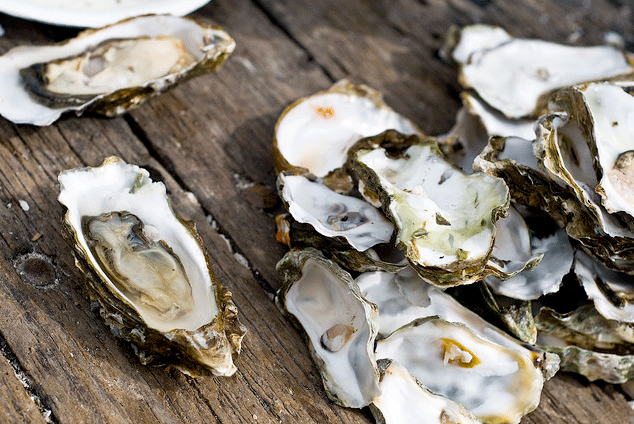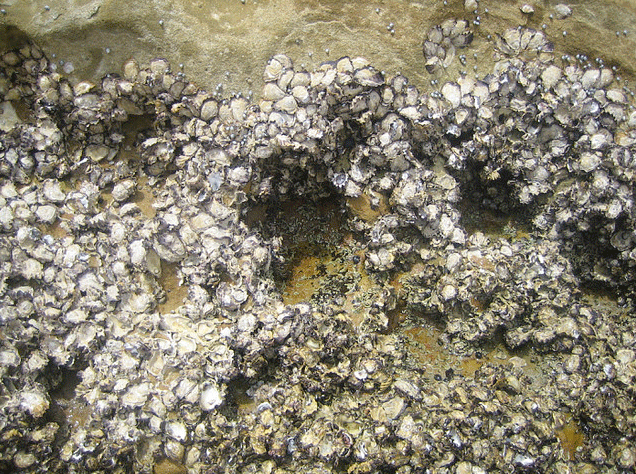Protecting Coastal Areas With….Oysters
Air Date: Week of November 2, 2012

Oysters on the half shell (Photo: Min Woo)
Oysters are a delicacy to some, but writer Paul Greenberg says they could have a more practical function. Greenberg tells host Steve Curwood that oysters once helped protect New York city from fierce storms.
Transcript
CURWOOD: So there are several ideas and suggestions for protecting New York from devastating storm surges in the future – barriers and gates, for example – but writer Paul Greenberg has one of his own… oysters.
That’s right, Greenberg wrote an op-ed for the New York Times that explained how centuries ago, oysters were a fundamental defense for the city. Paul Greenberg joins us by Skype now - and I gather you're at a friend's house because your home has lost power - is that right?
GREENBERG: Yeah - we're blacked out, as is all of lower Manhattan right now. We live on Broadway, right by Ground Zero at Zuccotti Park. So, we’re in an area that has power, but below 30th street it’s all blacked out.
CURWOOD: So what did it look like on your block this morning when you left?

Oyster beds add stability to coastal areas. (Photo: Jessica James)
GREENBERG: Well, the block itself was OK, I mean you see debris everywhere, but when you walk down the hill, it turns out that Broadway is a ridgeline. And when you walk downhill, past a certain point you start to see this waterline on buildings, and if you peer into the windows of bars and restaurants, it just looks like there was a huge bar fight with a lot of mud, so you see chairs and tables thrown all over the place. One place, a famous fish market restaurant called the Paris, had literally a stream of beer bottles coming out the door, and yes, people were picking them up and drinking them.
CURWOOD: Hah! What does it smell like, Paul?
GREENBERG: It smells a lot like gasoline or diesel. And, in fact, the sidewalks around the seaport area are sort of stippled with that rainbow hue of gas. It’s the sticky, gross, oily smell, with a little tinge of raw sewage along the edge.
CURWOOD: Oh my god! So how long do you think it’s going to take to clean something like this up? I mean, I don’t think New York is talking about days or even weeks to get back to normal…
GREENBERG: No… I mean, I used to work in places like Bosnia, and Georgia and other sort of war-torn places, and that’s really what it reminded me of. Yeah, we’ll probably get our subways up somewhat soon, yeah, maybe we’ll get our electricity going. But the café where I normally write, I saw them literally just like sweeping gallons of water out the door - and all these private businesses down there - I mean, this is a devastating lifetime event.
CURWOOD: Boy, that sounds pretty rough. Well, lets get back to your op-ed Paul, oysters?
GREENBERG: Yeah, so it turns out, once upon a time, New York and a lot of the east coast was literally covered in oysters. Oysters, what they do is when they are born they are little free-swimming larvae, and they set upon other oyster shells and they build shells of their own.
And if you do this enough times, time and time again over seven thousand years, which is what the time period is that we’re talking about - you end up with reefs. And so it turns out that New York City was girded by this temperate reef of oysters, just like tropical islands are girded by coral reefs.
What those do, is that they not only protect the near shore, because they stabilize it, a little bit further offshore, the reefs create undulation and contour to the harbor and actually break up the wave action before they actually hit the shore.
CURWOOD: Ah, so it minimizes erosion!
GREENBERG: It does. Unfortunately, for the last 400 years, we’ve pretty much hounded the oyster out of existence. For the first 300 years we just ate them mercilessly, and when we were done eating them, instead of tossing the shells back into the water, which would have been good because it would have been a home for more oysters, instead we burned a lot of the shell down for lime, which is used for plaster and other industrial uses. We crushed up the shell and used them for roadbeds. And, literally, just tore mile after cubic mile of these things out of the harbor and it’s almost like opening up a bleeding wound for the sea to come rushing back in.
CURWOOD: What kind of future is there in oysters as a barrier?
GREENBERG: You know, it’s going to have to be a collaboration between humans and oysters if we’d like oysters back in the harbor to help us. Oysters right now can’t form their own reefs in New York harbor. The currents are too swift, the water quality, while it’s better than it was, still, it requires some help from us.
What’s happened is though, a consortium of different organizations including Bay Keeper, Hudson River Foundation and a few others have built these test reefs – where the Army Corps of Engineers have laid down some rock – and on top of that you do what’s called spat-on shell, which is the little baby oysters that have already bonded to a little chunk of shell that is in turn connected to the reef.
The idea is that to get enough of these reefs planted throughout the harbor, they would produce a lot of larvae, they would produce a lot of shell and you could maybe get the momentum going so that you could start to reclaim some of this reef structure that we’ve lost.
CURWOOD: For a storm surge how many feet of protection do you think an oyster reef would provide?
GREENBERG: Well, I mean, you know that’s the devilish question. I mean, once upon a time these reefs were yards high – I mean, 10, 20, 30 feet high. It takes a long time to get to that point, but the thing about an oyster reef unlike a stop or flood gate that we’d have to build, oyster reefs build themselves.
If we get them going, they will build themselves higher and higher until they’re really at the height that they should be to ease the storm surge. And if you really want to kind of duck into the Gaia hypothesis that the earth protects itself, it’s kind of true of the oyster, because the oyster doesn’t like situation where it’s exposed to pounding sea. So when it creates reefs, it creates calmer water, which allows for more oysters to grow. So, in a way, if we could work out a relationship with the oyster where it’s helping itself, it’s also going to help us.
CURWOOD: OK, Paul, so imagine an oyster reef now 10, 20 feet high, how do you get a ship through there, how are you going to navigate through all of those oyster reefs?
GREENBERG: Well, you’re definitely going to have to have shipping channels. And it may be that some sort of solution to helping New York survive is going to be part oysters, part hardware that we’re going to have to plant in the harbor. There’s a very interesting landscape architect named Kate Orff, and her studio Scape Studio, she had an exhibit. She has this nice idea called “oyster-tecture.” Where you would basically build a series of structures… false floors, fuzzy rope, different things that oysters could attach to, that would create the reef structure throughout the different parts of the harbor.
And if you guided these in such a way, if you envision where you wanted to have your shipping channels, then conceivably you could start to build your reefs in such a way that they wouldn’t interfere with shipping.
CURWOOD: So, let’s just go to the bottom line here, Paul. If we had the level of oysters that were in New York harbor originally some 300 years ago, would Sandy have had the punch that she had?
GREENBERG: I think her punch would have been a blocked by a left hook, or some sort of blocking maneuver, I’m not a boxer (laughs), but it would have been softened. And keep in mind when I say an oyster reef being 10, 20 feet high, that’s sub-tidal. So, we’re not talking about a sea wall that would actually be higher than the storm surge, we’re talking about something below water that would block the energy of the incoming waves and I think would probably have done quite a bit to soften the blow.
Again, I’m not an engineer, I’m a writer, but the engineers and the scientists I’ve talked to like this idea and I don’t think that the Army Corps of Engineers would have invested their time and money into this project if they didn’t think that there was some sort of potential.
CURWOOD: A left hook, or I think in New York it’s Red Hook, isn’t it?
GREENBERG:Well, Red Hook got the left hook, unfortunately.
CURWOOD: Paul Greenberg is author of “Four Fish: The Future of the Last Wild Food.” Thank you, Paul.
GREENBERG: Thank you, Steve!
Links
Living on Earth wants to hear from you!
Living on Earth
62 Calef Highway, Suite 212
Lee, NH 03861
Telephone: 617-287-4121
E-mail: comments@loe.org
Newsletter [Click here]
Donate to Living on Earth!
Living on Earth is an independent media program and relies entirely on contributions from listeners and institutions supporting public service. Please donate now to preserve an independent environmental voice.
NewsletterLiving on Earth offers a weekly delivery of the show's rundown to your mailbox. Sign up for our newsletter today!
 Sailors For The Sea: Be the change you want to sea.
Sailors For The Sea: Be the change you want to sea.
 The Grantham Foundation for the Protection of the Environment: Committed to protecting and improving the health of the global environment.
The Grantham Foundation for the Protection of the Environment: Committed to protecting and improving the health of the global environment.
 Contribute to Living on Earth and receive, as our gift to you, an archival print of one of Mark Seth Lender's extraordinary wildlife photographs. Follow the link to see Mark's current collection of photographs.
Contribute to Living on Earth and receive, as our gift to you, an archival print of one of Mark Seth Lender's extraordinary wildlife photographs. Follow the link to see Mark's current collection of photographs.
 Buy a signed copy of Mark Seth Lender's book Smeagull the Seagull & support Living on Earth
Buy a signed copy of Mark Seth Lender's book Smeagull the Seagull & support Living on Earth

